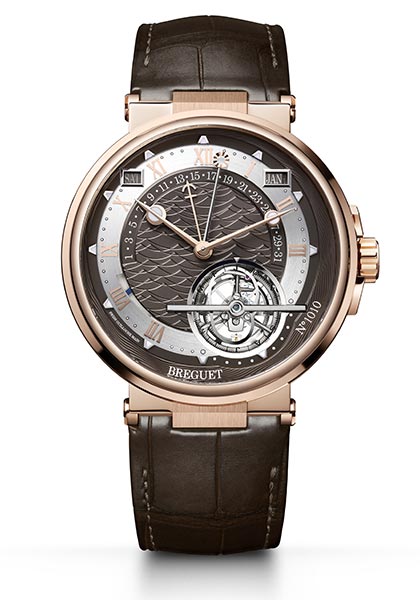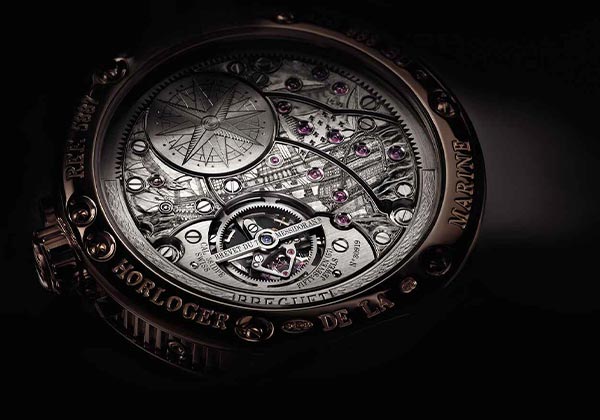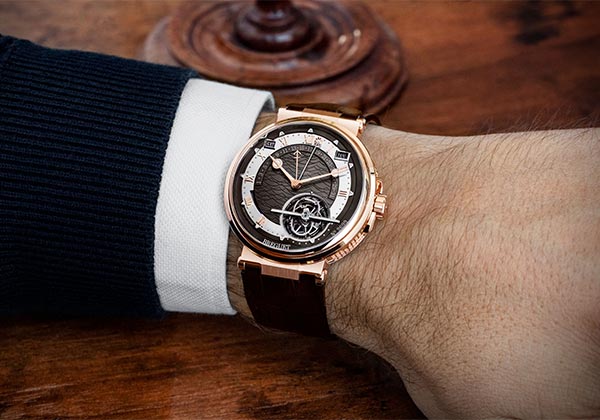While waiting for the commemorative model Breguet plans to release this fall, it is worth recalling that the brand at the pinnacle of the Swatch Group pyramid has never ceased to perpetuate this tradition, reinforced by 21st century technology. Last year in particular, the stunning Double Tourbillon Quai de l’Horloge from the Classique collection delighted collectors, while the Marine line evokes the triple historical expertise of the brand founder expressed through a more contemporary, slimmer and more efficient interpretation. Intrinsically linked to the tourbillon, Breguet also offers a reminder through this model that its inventor was appointed official watchmaker to the French Royal Navy, and that sophisticated horological complications such as the perpetual calendar and the equation of time hold no secrets for the venerable brand, which unite them here.

Derived from the ultra-thin self-winding Caliber 581 equipped with a tourbillon, this movement features an optimized design incorporating recent innovations such as a titanium carriage with a peripheral gear wheel driving its rotation, as well as a silicon balance and escape-wheel. Similarly, Breguet’s designers have achieved a one-quarter reduction in the barrel thickness by cutting a groove around the drum and holding it in place by means of three externally placed bearings. Connoisseurs will recognize the function of the hand tipped with a sun, indicating the minutes of solar time (different from the minutes of civil time driven by the main gear train) thanks to differential gearing and a cam on a sapphire disk performing one revolution in a year, followed by a feeler that provides the value of the equation of time. As for the anchor-tipped hand, it provides a retrograde date display. So as to improve the legibility of all these indications, Breguet completes the perpetual calendar indications by apertures showing the day and month, which are unique in its collections. The power reserve is discreetly shown on an arc-shaped gauge at 8 o’clock. All this information is easily readable on the attractive anthracite dial featuring white and gold contrasts, above which the majestic tourbillon appears to be floating in mid-air.

A whirlwind summer
On WorldTempus this summer, we’re getting swept up in the horological phenomenon that turns 220 this June.
The father of modern horology, 18th century watchmaker Abraham-Louis Breguet, observed that there might be a mechanical way to resolve all chronometric errors created by imperfectly poised regulators. By enclosing the regulating organ in a rotating cage, he would obtain one net error value for the regulator, in all its possible vertical positions over the period of one cage rotation. He could then make one single compensatory correction to the regulator and theoretically reduce the final error to zero.

He named his invention the tourbillon. Abraham-Louis Breguet received a patent for the tourbillon on 26 June 1801, and WorldTempus is celebrating the 220th anniversary of his remarkable invention with a series of articles and videos that explores this endlessly fascinating mechanism. How do you identify a tourbillon? What are the most common misunderstandings about it? What lies behind its hypnotic dance? How does it even work? Join us on WorldTempus this summer to discover all this and more.
As a World Tempus reader, we are delighted to offer you the latest digital version of this GMT magazine that you can download here. Happy reading!





